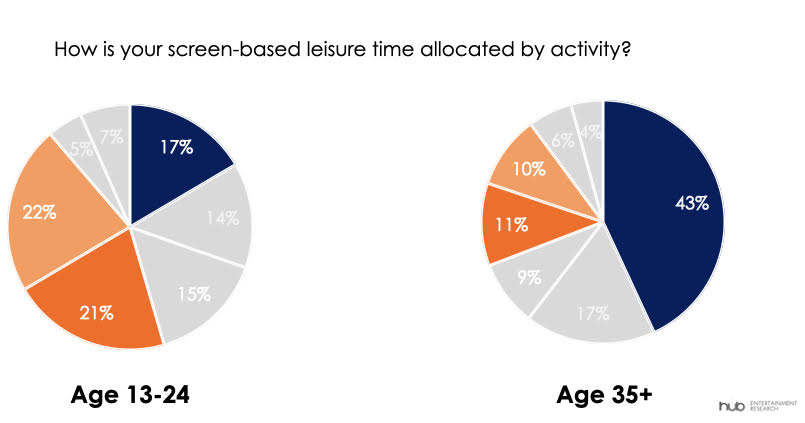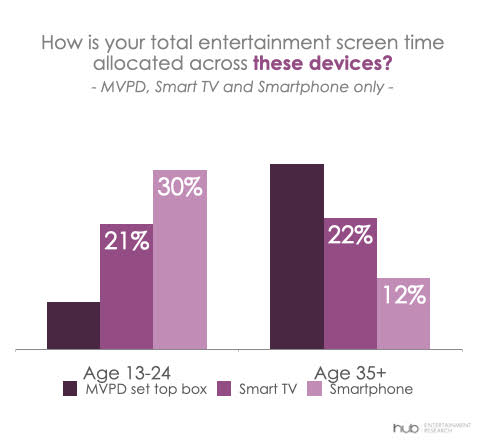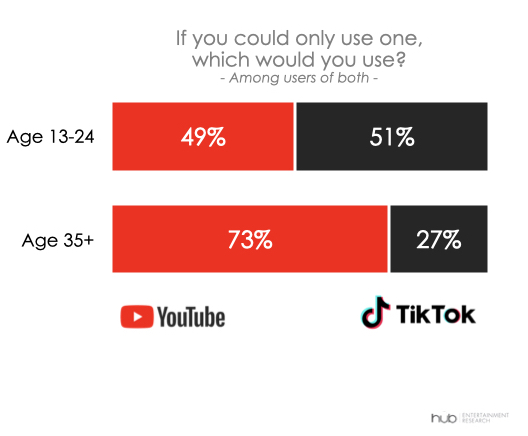TV Viewing Shrinks Among Gen Z
Those aged 13-24 spend only 17% of their time watching TV shows highlighting what the Hub calls an existential change in the entertainment ecosystem

New research continues to highlight a generational shift in the importance of the TV screen and traditional TV viewing among younger viewers aged 13 to 24, the so-called Gen Z cohort.
New TV research from Hub finds that the focus on the “streaming wars” overlooks a more existential change in entertainment ecosystem, with younger consumers 13-24 spending only 17% of their time viewing TV shows while viewers 35+ say they spend more time with TV than any other screen and that they spend about 43% of their total screen time watching TV.
Among viewers 35+, only about a fifth of their time goes to gaming or “non-premium” online video on platforms like YouTube or TikTok. Among those aged 13-24 this proportion is inverted: they estimate less than a fifth of their screen time (17%) is spent on TV shows. They spend more than twice that on gaming and non-premium video combined, a new Hub survey found.
“The ‘streaming wars’ monopolize the spotlight when it comes to predicting the fortunes of media companies in the future,” said Jon Giegengack, principal at Hub. “But this obscures an even more important shift: the next generation of TV consumers are just less engaged with traditional TV itself. Gaming and social video are the focus of their entertainment lifestyles. There’s no reason to assume they’ll grow out of these habits as they age. Media organizations need to adapt to these changes in order to meet tomorrow’s viewers on the devices and platforms where they will spend most of their time.”

The report doesn’t address how much of this shift may reflect changes in lifestyles as consumers age. Younger viewers may be less likely to own and have control over TV sets and that their viewing habits may change as they grow older, establish families, have kids and own TV sets that become the center of family viewing habits.
The researchers also noted that for decades, TV has been the center of the entertainment ecosystem. But for Gen Z consumers, it’s just one of several ways they spend their time.
While the TV screen is the home base for premium video content, Gen Z allocate as much time or more to content on other devices, the Hub survey found.
Get the TV Tech Newsletter
The professional video industry's #1 source for news, trends and product and tech information. Sign up below.
This disparity in content between the youngest consumers and their older counterparts is mirrored in the screens they use. Both groups allocate about a fifth of their total screen time to content on a smart TV. But otherwise, device usage of the two groups is very different.
Viewers age 35+ estimate they spend about a third of their total screen time watching content through a pay TV set top box and only 12% to entertainment on a phone. Those age 13-24 allocate the most time (30%) to content on their smartphone, and only 8% to content through a cable box.

TikTok has quickly become an entertainment hub for young consumers, the researchers also noted.
YouTube remains the biggest player in “non-premium” online video: more than 80 percent of respondents use it regularly. But TikTok has become indispensable to many young viewers, in a relatively short period of time. Among those age 13-24, two-thirds have used TikTok in the past week (second only to YouTube), the researchers said.
Among those using TikTok, 72% say they watch it every day (compared with just 48% of YouTube users in that age group) and among those who use both, more than half (51%) say they’d choose TikTok over YouTube if they could only have one.

The data cited here come from Hub’s “Video Redefined” study, conducted among 1,900 US consumers age 13-74. The data was collected in December 2022.
George Winslow is the senior content producer for TV Tech. He has written about the television, media and technology industries for nearly 30 years for such publications as Broadcasting & Cable, Multichannel News and TV Tech. Over the years, he has edited a number of magazines, including Multichannel News International and World Screen, and moderated panels at such major industry events as NAB and MIP TV. He has published two books and dozens of encyclopedia articles on such subjects as the media, New York City history and economics.

